A Comprehensive 2018-Based Vehicle Emission Inventory and Its Spatial–Temporal Characteristics in the Central Liaoning Urban Agglomeration, China
Abstract
:1. Introduction
2. Materials and Methods
2.1. Study Area
2.2. Emission Inventory Methodology
2.2.1. Investigation and Collection of Vehicle Activity Level Data
2.2.2. Emission Estimations
2.2.3. Calculation of Emission Factors
2.2.4. Spatial Distribution
2.2.5. Uncertainty Analysis
3. Results and Discussion
3.1. Traffic Composition
3.2. Vehicle Emission Inventory Characteristics
3.2.1. Emission Characteristics by Vehicle Type and Fuel Type
3.2.2. Emission Characteristics of Sub-Emission Standards
3.2.3. Characteristics of Each City
3.2.4. Spatial Distribution
3.2.5. Temporal Variation
3.3. Comparison with Other Inventories
3.4. Uncertainty Analysis
4. Conclusions
Supplementary Materials
Author Contributions
Funding
Institutional Review Board Statement
Informed Consent Statement
Data Availability Statement
Conflicts of Interest
References
- National Bureau of Statistics. China Statistical Yearbook 2019. Available online: http://www.stats.gov.cn/tjsj/ndsj/2019/indexch.htm (accessed on 5 February 2022).
- China Mobile Source Environmental Management Annual Report 2020. Available online: http://www.mee.gov.cn/xxgk2018/xxgk/xxgk15/202008/t20200810_793252.html (accessed on 5 February 2022).
- Tong, R.; Liu, J.; Wang, W.; Fang, Y. Health effects of PM2.5 emissions from on-road vehicles during weekdays and weekends in Beijing, China. Atmos. Environ. 2020, 223, 117258. [Google Scholar] [CrossRef]
- Tang, V.; Oanh, N.T.K.; Rene, E.R.; Binh, T.N. Analysis of roadside air pollutant concentrations and potential health risk of exposure in Hanoi, Vietnam. J. Environ. Sci. Health Part A Toxic Hazard. Subst. Environ. Eng. 2020, 55, 975–988. [Google Scholar] [CrossRef] [PubMed]
- Mohammadiha, A.; Malakooti, H.; Esfahanian, V. Development of reduction scenarios for criteria air pollutants emission in Tehran Traffic Sector, Iran. Sci. Total Environ. 2018, 622–623, 17–28. [Google Scholar] [CrossRef] [PubMed]
- Zheng, B.; Huo, H.; Zhang, Q.; Yao, Z.L.; Wang, X.T.; Yang, X.F.; Liu, H.; He, K.B. High-resolution mapping of vehicle emissions in China in 2008. Atmos. Chem. Phys. 2014, 14, 9787–9805. [Google Scholar] [CrossRef] [Green Version]
- Liu, Y.H.; Liao, W.Y.; Li, L.; Huang, Y.T.; Xu, W.J. Vehicle emission trends in China’s Guangdong Province from 1994 to 2014. Sci. Total Environ. 2017, 586, 512–521. [Google Scholar] [CrossRef] [PubMed]
- Gong, M.; Yin, S.; Gu, X.; Xu, Y.; Jiang, N.; Zhang, R. Refined 2013-based vehicle emission inventory and its spatial and temporal characteristics in Zhengzhou, China. Sci. Total Environ. 2017, 599-600, 1149–1159. [Google Scholar] [CrossRef]
- Zhang, L.; Hu, X.; Qiu, R.; Lin, J. Comparison of real-world emissions of LDGVs of different vehicle emission standards on both mountainous and level roads in China. Transp. Res. Part D Transp. Environ. 2019, 69, 24–39. [Google Scholar] [CrossRef]
- Yang, Z.; Liu, Y.; Wu, L.; Martinet, S.; Zhang, Y.; Andre, M.; Mao, H. Real-world gaseous emission characteristics of Euro 6b light-duty gasoline- and diesel-fueled vehicles. Transp. Res. Part D Transp. Environ. 2020, 78, 102215. [Google Scholar] [CrossRef]
- Huang, Y.; Organ, B.; Zhou, J.L.; Surawski, N.C.; Hong, G.; Chan, E.F.C.; Yam, Y.S. Emission measurement of diesel vehicles in Hong Kong through on-road remote sensing: Performance review and identification of high-emitters. Environ. Pollut. 2018, 237, 133–142. [Google Scholar] [CrossRef] [PubMed]
- Fu, X.; Wang, S.; Zhao, B.; Xing, J.; Cheng, Z.; Liu, H.; Hao, J. Emission inventory of primary pollutants and chemical speciation in 2010 for the Yangtze River Delta region, China. Atmos. Environ. 2013, 70, 39–50. [Google Scholar] [CrossRef]
- Hao, J.; He, D.; Wu, Y.; Fu, L.; He, K. A study of the emission and concentration distribution of vehicular pollutants in the urban area of Beijing. Atmos. Environ. 2000, 34, 453–465. [Google Scholar] [CrossRef]
- Chen, W.; Zhang, S.; Tong, Q.; Zhang, X.; Zhao, H.; Ma, S.; Xiu, A.; He, Y. Regional Characteristics and Causes of Haze Events in Northeast China. Chin. Geogr. Sci. 2018, 28, 836–850. [Google Scholar] [CrossRef] [Green Version]
- Sida, Q. Air Pollution Characteristics and Regional Transport of PM2.5 for Liaoning Province Using Models-3/CMAQ. Master’s Thesis, Liaoning University, Shenyang, China, 2018. [Google Scholar]
- Ying, S. Characteristics of Air Pollution in Major Cities of Liaoning Province and Source Apportionment of PM2.5 from 2014 to 2018. Master’s Thesis, China Medical University, Shenyang, China, 2020. [Google Scholar]
- Chung, J.H.; Lai, H.; Joo, J.H. Assessing the “Revive the Northeast” (zhenxing dongbei) Programme: Origins, Policies and Implementation. China Q. 2009, 197, 108–125. [Google Scholar] [CrossRef]
- Liaoning Provincal Bureau of Statistics, Liaoning Statistical Yearbook 2018. Available online: http://tjj.ln.gov.cn/tjsj/sjcx/ndsj/otherpages/2018/indexch.htm (accessed on 5 February 2022).
- Dan, W.; Li-ping, Z.; Yan-fang, Y.; Guang-feng, X.; Xuan, W.; Xue, Z.; Wei, H. Development of Vehicle Emission Inventory in Shenyang. Environ. Monit. Manag. Technol. 2018, 30, 30–33. [Google Scholar]
- Liping, Z. Establishment and Characteristics Analysis of Air Pollution Source Emission Inventory in Benxi City. Master’s Thesis, Liaoning University, Shenyang, China, 2019. [Google Scholar]
- Jiaxin, J.; Shida, S.; Peng, W.; Chao, L.Y.; Ting, W.; Lin, W.; Ning, W.; Junyu, C.; Hongjun, M. Vehicle Emission Inventory and Scenario Analysis in Liaoning from 2000 to 2030. Environ. Sci. 2020, 41, 665–673. [Google Scholar]
- Mengchen, Y.; Zu, B.; Qingxin, Z.; Penghui, L.; Yu, Z. Emission inventory and characteristics of anthropogenic air pollutant sources in Liaoning Province. Acta Sci. Circumstantiae 2018, 38, 1345–1357. [Google Scholar] [CrossRef]
- Ibarra-Espinosa, S.; Zhang, X.L.; Xiu, A.J.; Gao, C.K.; Wang, S.; Ba, Q.; Gao, C.; Chen, W.W. A comprehensive spatial and temporal vehicular emissions for northeast China. Atmos. Environ. 2021, 244, 12. [Google Scholar] [CrossRef]
- Liaoning Provincal Bureau of Statistics, Liaoning Statistical Yearbook 2020. Available online: http://tjj.ln.gov.cn/tjsj/sjcx/ndsj/otherpages/2020/2020/zk/indexch.htm (accessed on 5 February 2022).
- Liaoning Provincal Bureau of Statistics, Liaoning Statistical Yearbook 2017. Available online: http://tjj.ln.gov.cn/tjsj/sjcx/ndsj/otherpages/2017/indexch.htm (accessed on 5 February 2022).
- MEE. The Announcement about Releasing Five National Technical Guidelines of the Air Pollutant Emissions Inventory. Available online: http://www.mee.gov.cn/gkml/hbb/bgg/201501/t20150107_293955.htm (accessed on 5 February 2022).
- Iqbal, A.; Afroze, S.; Rahman, M. Probabilistic total PM2.5 emissions from vehicular sources in Australian perspective. Environ. Monit. Assess. 2021, 193, 575. [Google Scholar] [CrossRef] [PubMed]
- Maes, A.d.S.; Hoinaski, L.; Meirelles, T.B.; Carlson, R.C. A methodology for high resolution vehicular emissions inventories in metropolitan areas: Evaluating the effect of automotive technologies improvement. Transp. Res. Part D Transp. Environ. 2019, 77, 303–319. [Google Scholar] [CrossRef]
- Song, X.; Hao, Y. Vehicular Emission Inventory and Reduction Scenario Analysis in the Yangtze River Delta, China. Int. J. Environ. Res. Public Health 2019, 16, 4790. [Google Scholar] [CrossRef] [Green Version]
- EMEP/EEA. EMEP/EEA Air Pollutant Emission Inventory Guidebook 2019; EMEP/EEA: Copenhagen, Denmark, 2019. [Google Scholar]
- Huo, H.; Zhang, Q.; He, K.; Wang, Q.; Yao, Z.; Streets, D.G. High-resolution vehicular emission inventory using a link-based method: A case study of light-duty vehicles in Beijing. Environ. Sci. Technol. 2009, 43, 2394–2399. [Google Scholar] [CrossRef] [PubMed]
- Hu, J.; Wu, Y.; Wang, Z.; Li, Z.; Zhou, Y.; Wang, H.; Bao, X.; Hao, J. Real-world fuel efficiency and exhaust emissions of light-duty diesel vehicles and their correlation with road conditions. J. Environ. Sci. 2012, 24, 865–874. [Google Scholar] [CrossRef]
- Liu, H.; Man, H.; Cui, H.; Wang, Y.; Deng, F.; Wang, Y.; Yang, X.; Xiao, Q.; Zhang, Q.; Ding, Y.; et al. An updated emission inventory of vehicular VOCs and IVOCs in China. Atmos. Chem. Phys. 2017, 17, 12709–12724. [Google Scholar] [CrossRef] [Green Version]
- Wu, Y.; Zhang, S.J.; Li, M.L.; Ge, Y.S.; Shu, J.W.; Zhou, Y.; Xu, Y.Y.; Hu, J.N.; Liu, H.; Fu, L.X.; et al. The challenge to NOx emission control for heavy-duty diesel vehicles in China. Atmos. Chem. Phys. 2012, 12, 9365–9379. [Google Scholar] [CrossRef] [Green Version]
- Junyu, Z.; Wenwei, C.; Zhaoli, W. Traffic flow and road network-based spatial allocation of regional mobile source emission inventories. Acta Sci. Circumstantiae 2009, 29, 815–821. [Google Scholar]
- Gu, X.; Yin, S.; Lu, X.; Zhang, H.; Wang, L.; Bai, L.; Wang, C.; Zhang, R.; Yuan, M. Recent development of a refined multiple air pollutant emission inventory of vehicles in the Central Plains of China. J. Environ. Sci. 2019, 84, 80–96. [Google Scholar] [CrossRef]
- Zhou, Z.; Tan, Q.; Liu, H.; Deng, Y.; Wu, K.; Lu, C.; Zhou, X. Emission characteristics and high-resolution spatial and temporal distribution of pollutants from motor vehicles in Chengdu, China. Atmos. Pollut. Res. 2019, 10, 749–758. [Google Scholar] [CrossRef]
- Liu, Y.H.; Ma, J.L.; Li, L.; Lin, X.F.; Xu, W.J.; Ding, H. A high temporal-spatial vehicle emission inventory based on detailed hourly traffic data in a medium-sized city of China. Environ. Pollut. 2018, 236, 324–333. [Google Scholar] [CrossRef] [PubMed]
- Qi, J.; Zheng, B.; Li, M.; Yu, F.; Chen, C.; Liu, F.; Zhou, X.; Yuan, J.; Zhang, Q.; He, K. A high-resolution air pollutants emission inventory in 2013 for the Beijing-Tianjin-Hebei region, China. Atmos. Environ. 2017, 170, 156–168. [Google Scholar] [CrossRef]
- Wang, Y.J.; Ji, Z.; Yin, H.; Ding, Y.; Su, S.; Qian, L.Y.; Wang, J.F. Study of Parameters Influencing Measurement on Heavy Duty Diesel Vehicle’s Emission Factors. Res. Environ. Sci. 2014, 27, 232–238. [Google Scholar]
- Tao, S.C.; Deng, S.X.; Hao, Y.Z.; Gao, S.; Xiong, X.; Kong, Y. Vehicle emission characteristics of gaseous pollutants in Guanzhong urban agglomeration. China Environ. Sci. 2019, 39, 542–553. [Google Scholar] [CrossRef]
- Wu, Y.; Zhang, S.; Hao, J.; Liu, H.; Wu, X.; Hu, J.; Walsh, M.P.; Wallington, T.J.; Zhang, K.M.; Stevanovic, S. On-road vehicle emissions and their control in China: A review and outlook. Sci. Total Environ. 2017, 574, 332–349. [Google Scholar] [CrossRef] [Green Version]
- Guo, X.; Fu, L.; Ji, M.; Lang, J.; Chen, D.; Cheng, S. Scenario analysis to vehicular emission reduction in Beijing-Tianjin-Hebei (BTH) region, China. Environ. Pollut. 2016, 216, 470–479. [Google Scholar] [CrossRef] [PubMed]
- Zheng, J.; Che, W.; Wang, X.; Louie, P.; Zhong, L. Road-network-Based spatial allocation of on-road mobile source emissions in the Pearl River Delta region, China, and comparisons with population-based approach. J. Air Waste Manag. Assoc. 2009, 59, 1405–1416. [Google Scholar] [CrossRef] [Green Version]
- Jing, B.; Wu, L.; Mao, H.; Gong, S.; He, J.; Zou, C.; Song, G.; Li, X.; Wu, Z. Development of a vehicle emission inventory with high temporal–spatial resolution based on NRT traffic data and its impact on air pollution in Beijing—Part 1: Development and evaluation of vehicle emission inventory. Atmos. Chem. Phys. 2016, 16, 3161–3170. [Google Scholar] [CrossRef] [Green Version]
- Gao, C.; Gao, C.; Song, K.; Xing, Y.; Chen, W. Vehicle emissions inventory in high spatial–temporal resolution and emission reduction strategy in Harbin-Changchun Megalopolis. Process Saf. Environ. Prot. 2020, 138, 236–245. [Google Scholar] [CrossRef]
- Ran, Z. Liaoning Province will eliminate 100,000 yellow label vehicles in 2017. China Resour. Compr. Util. 2017, 35, 58. [Google Scholar]
- Yin, S.; Zheng, J.; Lu, Q.; Yuan, Z.; Huang, Z.; Zhong, L.; Lin, H. A refined 2010-based VOC emission inventory and its improvement on modeling regional ozone in the Pearl River Delta Region, China. Sci. Total Environ. 2015, 514, 426–438. [Google Scholar] [CrossRef]
- Jingling, W. Study and Evaluation on Pollution Characteristics and Control Policies of Motor Vehicles in the Yangtze River Delta Region. Master’s Thesis, Zhejiang University, Hangzhou, China, 2018. [Google Scholar]
- Yang, L.; Zeng, W.; Zhang, Y.; Liu, Y.; Liao, C.; Gan, Y.; Deng, X. Establishment of emission inventory and spatial-temporal allocation model for air pollutant sources in the Pearl. River Delta region. China Environ. Sci. 2015, 35, 3521–3534. [Google Scholar]
- Guo, H.; Zhang, Q.; Shi, Y.; Wang, D. On-road remote sensing measurements and fuel-based motor vehicle emission inventory in Hangzhou, China. Atmos. Environ. 2007, 41, 3095–3107. [Google Scholar] [CrossRef]
- Wang, H.; Chen, C.; Huang, C.; Fu, L. On-road vehicle emission inventory and its uncertainty analysis for Shanghai, China. Sci. Total Environ. 2008, 398, 60–67. [Google Scholar] [CrossRef] [PubMed]
- Lang, J.; Cheng, S.; Zhou, Y.; Zhang, Y.; Wang, G. Air pollutant emissions from on-road vehicles in China, 1999–2011. Sci. Total Environ. 2014, 496, 1–10. [Google Scholar] [CrossRef]
- Jiang, P.; Chen, X.; Li, Q.; Mo, H.; Li, L. High-resolution emission inventory of gaseous and particulate pollutants in Shandong Province, eastern China. J. Clean. Prod. 2020, 259, 120806. [Google Scholar] [CrossRef]
- Jiang, P.; Zhong, X.; Li, L. On-road vehicle emission inventory and its spatio-temporal variations in North China Plain. Environ. Pollut. 2020, 267, 115639. [Google Scholar] [CrossRef]
- Lv, W.; Hu, Y.; Li, E.; Liu, H.; Pan, H.; Ji, S.; Hayat, T.; Alsaedi, A.; Ahmad, B. Evaluation of vehicle emission in Yunnan province from 2003 to 2015. J. Clean. Prod. 2019, 207, 814–825. [Google Scholar] [CrossRef]
- Yang, W.; Yu, C.; Yuan, W.; Wu, X.; Zhang, W.; Wang, X. High-resolution vehicle emission inventory and emission control policy scenario analysis, a case in the Beijing-Tianjin-Hebei (BTH) region, China. J. Clean. Prod. 2018, 203, 530–539. [Google Scholar] [CrossRef]
- Sun, S.; Jin, J.; Xia, M.; Liu, Y.; Gao, M.; Zou, C.; Wang, T.; Lin, Y.; Wu, L.; Mao, H.; et al. Vehicle emissions in a middle-sized city of China: Current status and future trends. Environ. Int. 2020, 137, 105514. [Google Scholar] [CrossRef] [PubMed]
- Zhang, S.; Wu, Y.; Liu, H.; Wu, X.; Zhou, Y.; Yao, Z.; Fu, L.; He, K.; Hao, J. Historical evaluation of vehicle emission control in Guangzhou based on a multi-year emission inventory. Atmos. Environ. 2013, 76, 32–42. [Google Scholar] [CrossRef]
- Liu, H.; Chen, X.; Wang, Y.; Han, S. Vehicle Emission and Near-Road Air Quality Modeling for Shanghai, China: Based on Global Positioning System Data from Taxis and Revised MOVES Emission Inventory. Transp. Res. Rec. 2013, 2340, 38–48. [Google Scholar] [CrossRef]
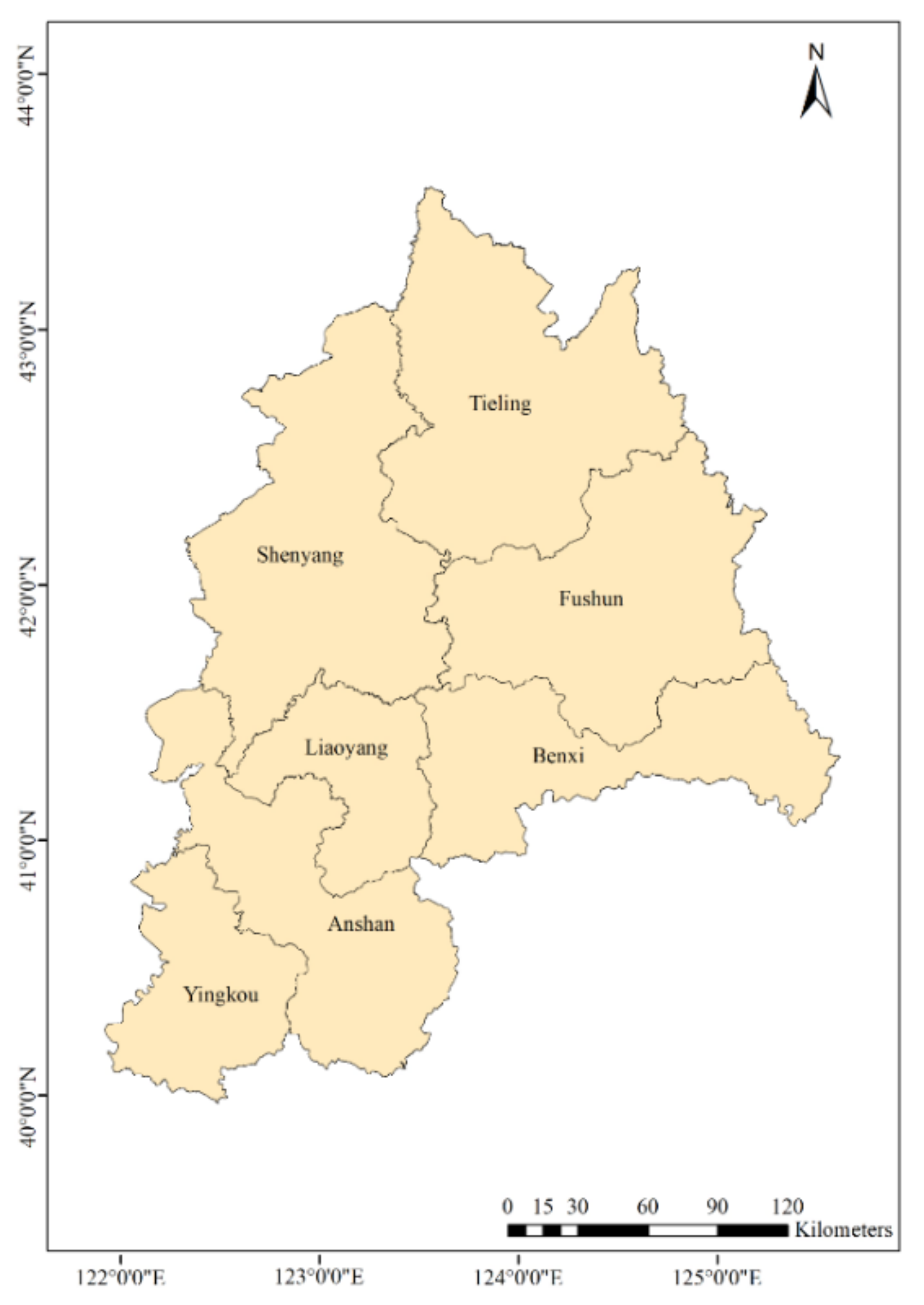
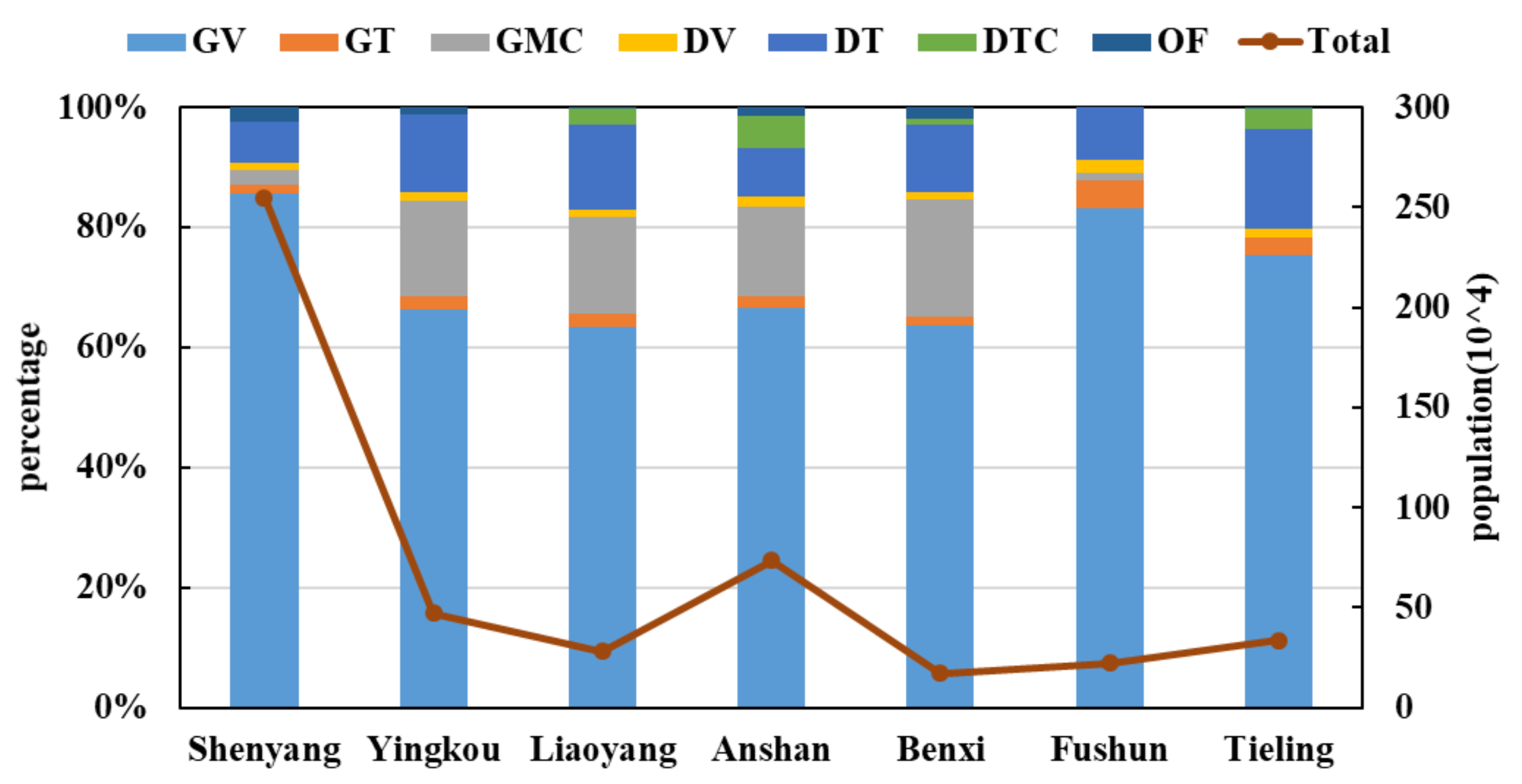

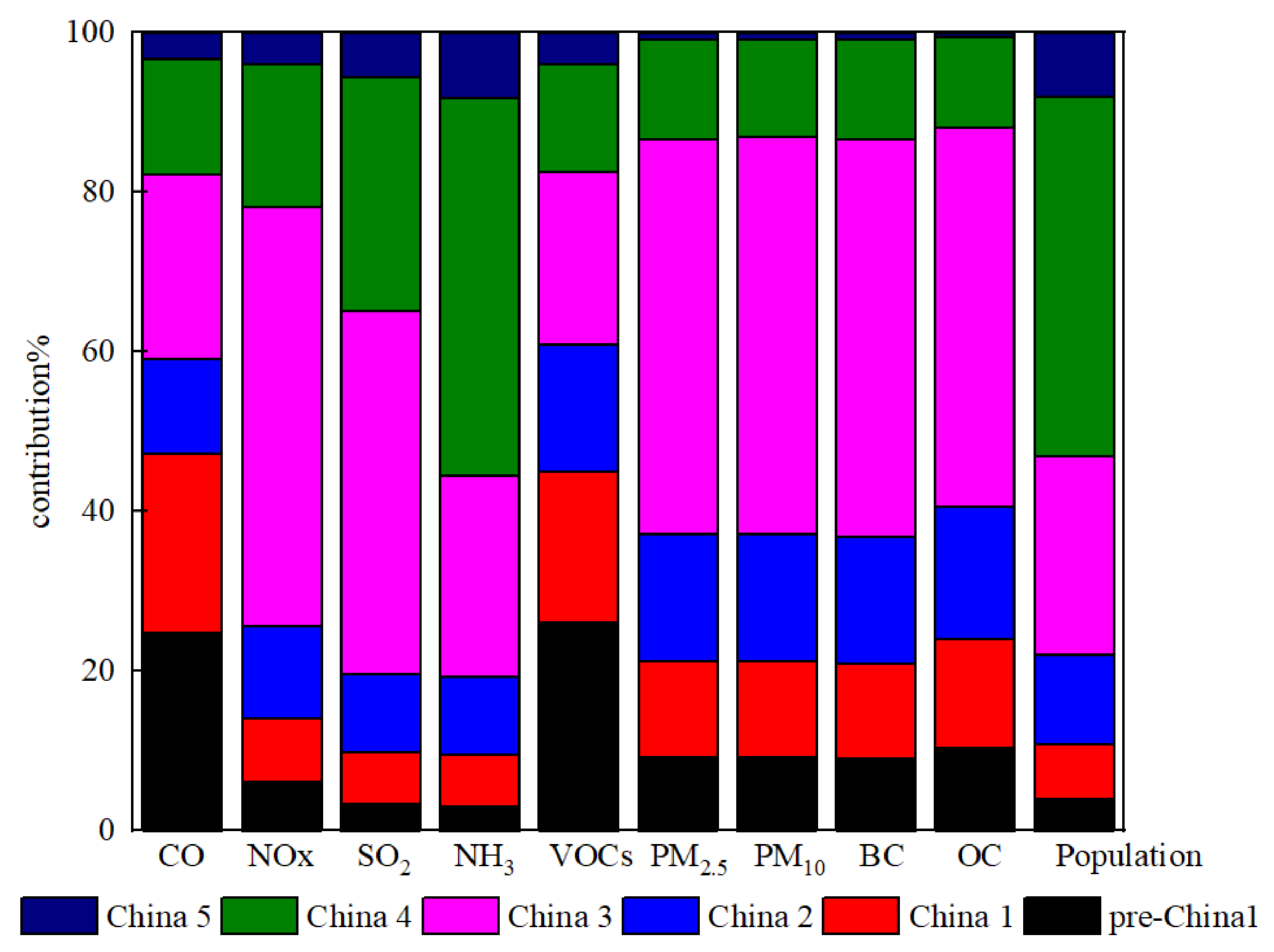
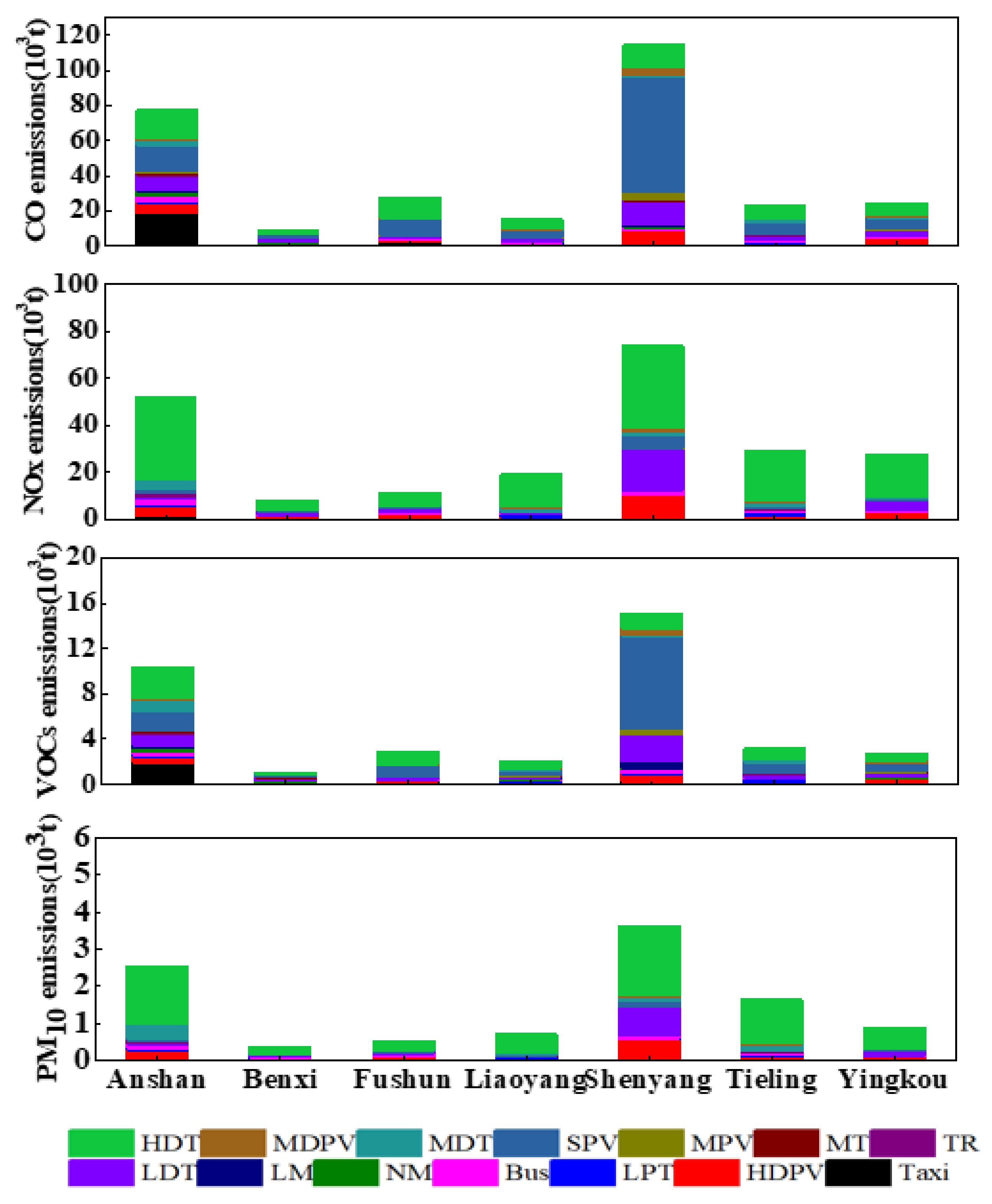
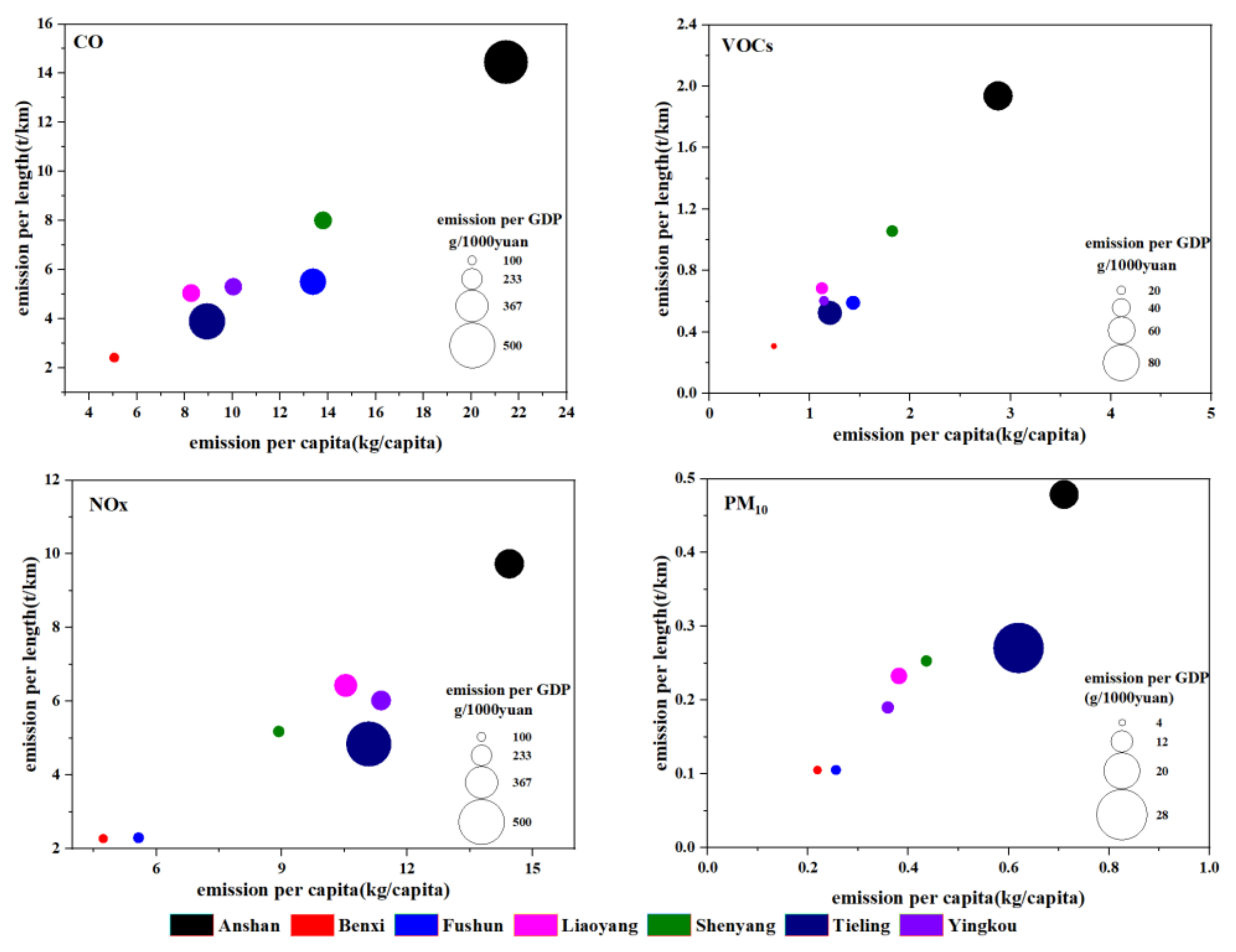



| City | Statistics Level | Data Year | Data Sources |
|---|---|---|---|
| Shenyang | City | 2018 | Public security bureau |
| Yingkou | City | 2017 | Traffic control department and vehicle pollution supervision and management department |
| Liaoyang | City | 2017 | Supervision and management department |
| Benxi | City | 2017 | Supervision and management department |
| Fushun | City | 2017 | Supervision and management department |
| Anshan | Subdistrict | 2017 | Supervision and management department |
| Tieling | City | 2018 | Liaoning statistical yearbook |
| Fuel | Vehicle | Population | Emission Standard Distribution (%) | |||||
|---|---|---|---|---|---|---|---|---|
| Pre-China 1 | China 1 | China 2 | China 3 | China 4 | China 5 | |||
| Gasoline | Taxi | 25,951 | 13.6 | 9.1 | 7.6 | 15.8 | 45.2 | 8.8 |
| HDPV | 6815 | 11.7 | 5.6 | 33.9 | 32.7 | 15.7 | 0.3 | |
| Bus | 581 | 74.5 | 9.3 | 15.9 | 0.2 | - | - | |
| NM | 292,709 | 13.6 | 13.3 | 34.2 | 38.8 | - | 0.1 | |
| LM | 35,556 | 77.9 | 11.3 | 6.5 | 3.7 | - | 0.5 | |
| LDT | 84,094 | 8.8 | 5.7 | 7.3 | 29.3 | 42.8 | 6.1 | |
| MT | 975 | 43.4 | 23 | 12.9 | 19.2 | 1.4 | 0.1 | |
| MPV | 54,035 | 12 | 37 | 16.5 | 18.7 | 15.6 | 0.1 | |
| SPV | 3,595,323 | 1.8 | 5.4 | 9.2 | 20.5 | 54 | 9.2 | |
| MDT | 1806 | 4.4 | 2.2 | 7.7 | 61.7 | 20.8 | 3.2 | |
| MDPV | 19,653 | 10.1 | 13.2 | 48.2 | 12 | 16 | 0.6 | |
| HDT | 4475 | 5.1 | 37.9 | 20.2 | 27.8 | 1.3 | 7.8 | |
| subtotal | 4,121,973 | 3.7 | 6.5 | 11.2 | 21.7 | 48.5 | 8.3 | |
| Diesel | Taxi | 714 | 5.6 | 9.8 | 28.4 | 29.8 | 26.3 | - |
| HDPV | 24,474 | 3 | 5.2 | 8 | 52.8 | 29.6 | 1.4 | |
| LPT | 30,870 | 16.4 | 18.8 | 64.8 | - | - | - | |
| Bus | 7733 | 1 | 8.4 | 6 | 76.8 | 6.4 | 1.4 | |
| LDT | 171,431 | 0.0 | 2 | 6.9 | 76.5 | 9.9 | 4.7 | |
| TR | 63,740 | 39.3 | 47.6 | 13 | - | - | 0.1 | |
| MT | 1008 | - | - | 1.1 | 98.9 | - | - | |
| MPV | 2 | - | 100 | - | - | - | - | |
| SPV | 27,033 | 7.1 | 2.9 | 10.7 | 73 | 3.1 | 3.1 | |
| MDT | 36,019 | 13.5 | 10.2 | 10.9 | 48 | 13 | 4.4 | |
| MDPV | 9556 | 2.5 | 7.8 | 14.4 | 47.4 | 25.5 | 2.4 | |
| HDT | 185,857 | 1.4 | 4.9 | 8.7 | 51.4 | 27.9 | 5.7 | |
| subtotal | 558,437 | 7.3 | 10 | 12 | 51.6 | 15.1 | 3.9 | |
| Other fuels | Taxi | 28,455 | 0 | - | 0 | 0.6 | 96.7 | 2.7 |
| HDPV | 8129 | - | - | 0.2 | 2.6 | 10.7 | 86.6 | |
| Bus | 6531 | - | - | 1.7 | 7.5 | 21.2 | 69.6 | |
| LDT | 210 | - | - | 0.5 | 0.5 | 54.3 | 44.8 | |
| MPV | 101 | - | 1 | 0.5 | - | 91.5 | 6.9 | |
| SPV | 35,124 | 0.3 | 0.1 | 0.5 | 1.2 | 84.8 | 13.1 | |
| MDT | 2 | - | - | - | - | 50 | 50 | |
| MDPV | 2928 | - | 0 | 2.9 | 1.7 | 68.3 | 27 | |
| HDT | 350 | - | - | - | 0.9 | 18 | 81.1 | |
| subtotal | 81,831 | 0.2 | 0 | 0.5 | 1.6 | 75.5 | 22.2 | |
| Total | 4,762,241 | 4.1 | 6.8 | 11.1 | 24.9 | 45.1 | 8 | |
| City | CO | NOx | SO2 | NH3 | VOCs | PM2.5 | PM10 | BC | OC |
|---|---|---|---|---|---|---|---|---|---|
| Yingkou | 24,462.4 | 27,729.7 | 444.1 | 223.3 | 3211.6 | 792.4 | 875.3 | 438.7 | 131.6 |
| Shenyang | 114,394.7 | 74,042.1 | 1297.4 | 1158.5 | 17,809.7 | 3285.6 | 3615.6 | 1808.9 | 552.0 |
| Liaoyang | 15,202.4 | 19,338.1 | 328.7 | 129 | 2307.8 | 630.3 | 700.1 | 358.3 | 105.9 |
| Anshan | 77,194.2 | 51,959.3 | 738.6 | 347.5 | 11,362.7 | 2311.5 | 2556.1 | 1301.9 | 411.9 |
| Benxi | 8519 | 7980.9 | 123.2 | 68.7 | 1308.9 | 335.5 | 369.3 | 187.9 | 56.3 |
| Fushun | 27,616.8 | 11,511.9 | 182.9 | 137.4 | 3295.2 | 478.8 | 528 | 259.8 | 83.6 |
| Tieling | 23,571.5 | 29,228.5 | 468.4 | 181.2 | 3455.1 | 1468.9 | 1634.3 | 844.1 | 246.8 |
| Total | 290,960.8 | 221,790.6 | 3583.4 | 2245.6 | 42,751.0 | 9303 | 10,278.6 | 5199.6 | 1588.1 |
| Area | Base Year | Population (104) | Emission(kt/a) | Reference | ||||||||
|---|---|---|---|---|---|---|---|---|---|---|---|---|
| SO2 | NOx | CO | PM10 | PM2.5 | VOCs | NH3 | BC | OC | ||||
| CLUA | 2018 | 476.2 | 3.6 | 221.8 | 291.0 | 10.3 | 9.3 | 37.5 | 2.2 | 5.2 | 1.6 | This study |
| Liaoning Province | 2012 | 4.6 | 288.7 | 789.0 | 14.6 | 13.1 | 2.5 | 7.0 | 2.2 | [22] | ||
| BTH | 2013 | 29.5 | 775.6 | 1853.8 | 47.6 | 46.3 | 176.2 | 4.0 | 26.4 | 9.1 | [39] | |
| PRD | 2010 | 433.5 | [48] | |||||||||
| YRD | 2010 | 2748.4 | 34.3 | 691.2 | 40.2 | 38.6 | 515.9 | 13.2 | [12] | |||
| HCM | 2016 | 714.0 | 211.3 | 625.6 | 12.2 | 11.2 | 80.5 | 5.2 | [46] | |||
| YRD | 2015 | 3142.0 | 1123.4 | 2943.0 | 47.2 | [49] | ||||||
| PRD | 2012 | 9.0 | 348.9 | 1859.8 | 35.5 | 28.9 | 213.9 | 4.5 | [50] | |||
| NEC | 2016 | 2.0 | 518.2 | 1420.2 | 19.0 | 17.1 | 10.1 | [23] | ||||
| Shenyang | 2018 | 254.7 | 1.3 | 74.0 | 114.4 | 3.6 | 3.3 | 17.8 | 1.2 | 1.8 | 0.6 | This study |
| Shenyang | 2013 | 139.8 | 44.2 | 128.5 | 2.0 | [19] | ||||||
Publisher’s Note: MDPI stays neutral with regard to jurisdictional claims in published maps and institutional affiliations. |
© 2022 by the authors. Licensee MDPI, Basel, Switzerland. This article is an open access article distributed under the terms and conditions of the Creative Commons Attribution (CC BY) license (https://creativecommons.org/licenses/by/4.0/).
Share and Cite
Liu, Y.; Zhao, X.; Wang, J.; Zhu, S.; Han, B.; Zhao, D.; Wang, X.; Geng, C. A Comprehensive 2018-Based Vehicle Emission Inventory and Its Spatial–Temporal Characteristics in the Central Liaoning Urban Agglomeration, China. Int. J. Environ. Res. Public Health 2022, 19, 2033. https://doi.org/10.3390/ijerph19042033
Liu Y, Zhao X, Wang J, Zhu S, Han B, Zhao D, Wang X, Geng C. A Comprehensive 2018-Based Vehicle Emission Inventory and Its Spatial–Temporal Characteristics in the Central Liaoning Urban Agglomeration, China. International Journal of Environmental Research and Public Health. 2022; 19(4):2033. https://doi.org/10.3390/ijerph19042033
Chicago/Turabian StyleLiu, Yingying, Xueyan Zhao, Jing Wang, Shengnan Zhu, Bin Han, Di Zhao, Xinhua Wang, and Chunmei Geng. 2022. "A Comprehensive 2018-Based Vehicle Emission Inventory and Its Spatial–Temporal Characteristics in the Central Liaoning Urban Agglomeration, China" International Journal of Environmental Research and Public Health 19, no. 4: 2033. https://doi.org/10.3390/ijerph19042033






